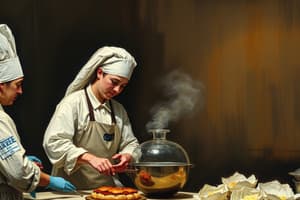Podcast
Questions and Answers
What should you consider when purchasing food?
What should you consider when purchasing food?
- Choose suppliers based on price alone
- Purchase food from any local store
- Accept food without checking supplier credentials
- Buy only from suppliers who get their products from approved and reputable suppliers (correct)
What must suppliers do before delivering food?
What must suppliers do before delivering food?
Deliver food when staff has enough time to do inspections.
The temperature for receiving TCS food, such as fish, should be ___.
The temperature for receiving TCS food, such as fish, should be ___.
41 F or lower
What should be done when receiving key drop deliveries?
What should be done when receiving key drop deliveries?
Recalls happen only if food is confirmed contaminated.
Recalls happen only if food is confirmed contaminated.
What is the maximum air temperature for receiving live shellfish?
What is the maximum air temperature for receiving live shellfish?
What must you do for receiving shucked shellfish?
What must you do for receiving shucked shellfish?
What is the procedure to follow if you need to reject a food item?
What is the procedure to follow if you need to reject a food item?
How long must documents for keeping fish and shellfish be kept?
How long must documents for keeping fish and shellfish be kept?
What is FIFO in food storage?
What is FIFO in food storage?
How many days can ready-to-eat TCS foods be stored before discarding?
How many days can ready-to-eat TCS foods be stored before discarding?
Flashcards are hidden until you start studying
Study Notes
General Food Purchasing Principles
- Purchase only from approved and reputable suppliers.
- Prioritize safety and integrity of the food source.
Deliveries
- Schedule food deliveries to allow sufficient time for inspections.
- Ensure delivery times align with staff availability.
Receiving and Inspecting
- Assign specific staff to handle food receiving.
- Equip staff with necessary tools like purchase orders and thermometers.
- Conduct visual inspections of delivery vehicles for contamination.
Key Drop Deliveries
- Permits suppliers to deliver food after hours with access keys.
- Food must be properly stored in coolers, freezers, or dry storage.
- Delivery must be inspected upon site arrival.
Procedure for Rejecting Items
- Clearly communicate issues to the delivery person.
- Obtain a signed adjustment of the rejected items.
- Document incidents on invoices or receiving documents.
Recalls
- Initiated upon confirmed or suspected food contamination or mislabeling.
- Vendors typically notify recipients, but monitoring for recalls is essential.
Receiving Temperature Requirements
- TCS foods, such as fish, must be received at 41°F or lower.
- Live shellfish requires an air temperature of 45°F and internal temperature below 50°F, cooling to 41°F within four hours.
- Shucked shellfish, milk, and eggs must also be received at or below 45°F.
- Hot foods should be received at 135°F or higher.
- Frozen foods must be solidly frozen upon delivery.
Rejecting Frozen Food Delivery
- Reject if there are fluids or water stains on packaging.
- Discard foods showing ice crystals or signs indicating thawing and refreezing.
Packaging and Acceptance Criteria
- Reject items with damaged packaging or signs of tampering.
- Do not accept items with leaks, pest damage, or missing expiration dates.
- Ensure all items are correctly dated and labeled.
Document Retention for Fish and Shellfish
- Keep records for 90 days from the last use of fish.
Food Quality Indicators
- Reject food exhibiting signs of time-temperature abuse, including poor appearance, texture, and odor.
Guidelines for Food Storage
- Ensure all items are labeled and dated.
- Rotate foods to maintain freshness and prevent cross-contamination.
Importance of Food Labeling
- Prevent illnesses caused by misidentifying chemicals and allergens.
- Ensure safety in handling food products.
Labeling Procedures for Onsite Use
- Label all items not in original containers with their contents.
- Date mark all food items for tracking.
Ready-to-Eat TCS Foods Storage Period
- Can be stored for a maximum of 7 days before consumption or disposal.
Temperature Check Procedures
- For meats, poultry, and fish: Insert thermometer into the thickest part.
- For packaged dairy products: Open package and insert thermometer without touching packaging.
- For ROP foods: Insert thermometer probe between packages without puncturing them.
FIFO (First In, First Out) Method
- A method of inventory rotation ensuring older stock is used first.
Importance of Temperature Check for ROP Food
- Ensures correct handling and prevents potential spoilage or contamination while maintaining product integrity.
Studying That Suits You
Use AI to generate personalized quizzes and flashcards to suit your learning preferences.




